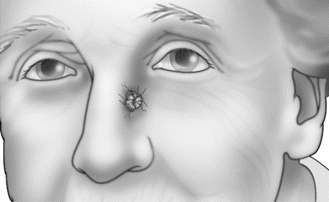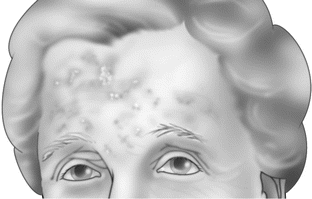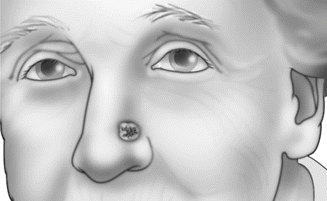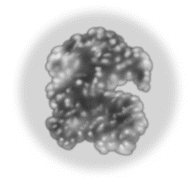, Toral Patel3, 4, Neill T. Peters3, 2 and Sarah Kasprowicz5
(1)
Northwestern University Feinberg School of Medicine, Chicago, IL, USA
(2)
Medical Dermatology Associates of Chicago, Chicago, IL, USA
(3)
Instructor of Clinical Dermatology, Northwestern University Feinberg School of Medicine, Chicago, IL, USA
(4)
D&A Dermatology, Chicago, IL, USA
(5)
NorthShore University HealthSystem, University of Chicago, Pritzker School of Medicine, Chicago, IL, USA
Keywords
CancerActinic keratosisBasal cell carcinomaSquamous cell carcinomaMelanomaIngenol mebutateSolasodine glycosidesVitamin DEscharoticsCoenzyme Q10GossypinIntroduction
It is estimated that one in five Americans will develop skin cancer in their lifetime and that up to 50% of Americans who live to age 65 will develop either basal cell carcinoma (BCC) or squamous cell carcinoma (SCC) at least once (http://progressreport.cancer.gov). Treatment of non-melanoma skin cancers has increased by 77% between 1992 and 2006 (Rogers 2010; http://cancer.org/acs/group/content/@epidemiologysurveilance/document036845.pdf), leading to continual reassessment of treatment. Morbidity has been minimized with techniques such as Mohs Micrographic surgery, and excellent cure rates have been reported (Clark et al. 2014; Mostterd et al. 2008). For malignant melanoma, by far the most dangerous of these three skin cancers, the outcomes are far less rosy, with good cure rates for thin tumors, but poor rates for thicker, invasive lesions. Importantly, options for metastatic melanoma are limited, with modest life prolongation at best. In fact, patients with visceral metastases have medial survival rates of only 4 months (Fox et al. 2013). Nonetheless, newer immunotherapies such as ipilimumab and PD1 inhibitors now offer hope to melanoma patients with advanced disease (Fox et al. 2013).
Some skin cancer patients find the cost and/or resultant excision scar unsatisfactory, or fear surgery altogether. Perhaps surprisingly, complementary and alternative (CAM) therapy options are being increasingly sought out and utilized by skin cancer patients. In one survey, the prevalence of CAM use among adults reporting skin problems was nearly 50% (Smith et al. 2010).
As patients seek alternative options to conventional therapy for skin cancer, the use of ‘natural products’ cannot be assumed to mean ‘safe’. Health providers need to be aware of several specific alternative therapies for skin cancer, some promising and others plainly dangerous. Some of these natural products have lead to major discoveries in skin cancer research (cyclopamine) or have proven efficacy (ingenol mebutate). However, randomized controlled trials (RCT) demonstrating efficacy and safety of alternative therapies are necessary before they can be considered viable options in the management of skin cancer.
It is important to stress that invasive basal and squamous cell cancers, as well as all melanomas can metastasize and cause significant morbidity and even mortality. Failing to use proven techniques to properly diagnose (i.e., biopsy) and to surgically resect or debulk these tumors greatly increases the risk for poor outcomes, and may increase the medicolegal risk in such cases. Because of the inherent dangers of skin cancer, only adjuvants to conventional care should be considered until sufficient evidence displaces current standards of care.
Clinical Considerations
Top Considerations
See Table 4.1.
Table 4.1.
Top considerations for skin cancer.
Treatment | How administered | Notes |
|---|---|---|
Ingenol mebutate | Topically as 0.05% gel for the body (applied once daily for 2 days) and 0.015% for the face and scalp (once daily for 3 days) | FDA-approved and effective for AKs, easy to apply for short duration; local reactions common, but relatively mild |
Solasodine glycosides (BEC) | Topically as 0.005% cream (BID × 7–60 days) | Limited data for AK, SCC, and BCC; no data for melanoma. Perhaps could be used in special circumstances as an adjunct to surgery or alternative trial for low-risk lesions under close supervision |
Vitamin D | Daily or weekly supplementation. Optimal dosing is unclear | Some studies suggest protective effect and survival advantage for melanoma; Safe and inexpensive |
Coenzyme Q10 | 200 mg PO BID | May reduce risk of metastasis and potentiate efficacy of adjuvant therapies; data is very limited |
Not Recommended
The escharotics (i.e., bloodroot, sanguinarine, and related compounds) should be avoided for known malignancies as they are unpredictable and have not reliably been shown to be a viable treatment without concomitant surgery.
Gossypin (an extract from cotton and hibiscus plants) has some promising data in mice and in vitro for melanoma, but is simply too experimental for clinical use at this time.
Ingenol Mebutate
Actinic keratoses (AKs) are common scaling, epidermal lesions occurring on sun exposed skin (Uhlenake 2013). These lesions have the potential to transform into SCC, and estimates of the annual rate of transformation range from 0.025 to 20% (Marks et al. 1988). Given the lack of clinical features that allow clinicians to identify the lesions most likely to progress, clinicians are obligated to treat AKs as a preventative measure (Uhlenake 2013). These therapies include cryotherapy, photodynamic therapy, topical chemotherapy, and topical field therapy with agents such as imiquimod and ingenol mebutate (Uhlenake 2013). Ingenol is a novel agent derived from Euphorbia peplus, a temperate annual weed, known as radium weed, petty spurge, or milkweed (Rosen et al. 2012). The sap of E peplus is irritating and has been used for centuries as a natural folk remedy for warts and AK (Rosen et al. 2012). It was approved for the treatment of AK in 2013 and is available in 0.05% gel for the body (applied once daily for 2 days) and 0.015% for the face and scalp (once daily for 3 days), Ingenol is thought to have several mechanisms of action. These include disruption of mitochondrial membranes resulting in cytotoxicity, activation of proinflamatory cytokines, recruitment of neutrophils, and generation of tumor specific antibodies (Rosen et al. 2012). Complete clearance of facial lesions was 47% of individuals at 57 days and mean reduction of lesions was 87% mean reduction of lesions from baseline for face and scalp. Pooled analysis of 4 trials (2 face and scalp, 2 body) concluded that 42.2% of face and scalp lesions cleared and 34.1% affected body areas cleared. Adverse reactions include erythema, scabbing and scaling and were mild to moderate in severity. Unlike escharotics, randomized controlled trials have confirmed the efficacy of naturally occurring ingenol mebutate for the topical field treatment of actinic keratoses. Ingenol is presently being studied for therapy of BCC (Clark et al. 2014) and it has been recently reported to help pediatric molluscum as an off label indication (Javed and Tyring 2014).
Evidence for Ingenol Mebutate
1.
The European Medicines Agency approval of ingenol mebutate (Picato) for the cutaneous treatment of non-hyperkeratotic, non-hypertrophic actinic keratosis in adults: Summary of the scientific assessment of the Committee for Medicinal Products for Human Use (CHMP). Tzogani K, Nagercoil N, Hemmings RJ, Samir B, Gardette J, Demolis P, Salmonson T, Pignatti F. Eur J Dermatol. 2014 Jul-Aug;24(4):457–63.
A large scientific review that examined 25 clinical studies, 18 in patients with AK. A complete response rate of 42.2% on the face and scalp and 34.1% on the trunk and extremities was reported, with local skin reactions being the most common side effects. This medication is now FDA-approved in the United States as being safe and effective for the treatment of AK.
Solasodine Glycosides (BEC)
Sometimes marketed under the name Curaderm, BEC is used for AK and non-melanoma skin cancer. Containing naturally occurring glycoalkaloids found in both eggplant and Solanum sodomaeum (Devil’s Apple), the manufacturer suggests that the compound is highly toxic to skin cancer cells when applied twice daily for 7–60 days for AK and small skin cancers (http://www.antiaging-systems.com/23-bec5-curaderm?Aff=WRC1). The manufacturer also indicates that Curaderm causes no harm to healthy cells. The active ingredient is thought to be rhamnose sugar moieties (solasodine glycosides). Healthy skin cells do not express receptors for these sugar moieties while cancer cells do. Via these receptors, it is thought that BEC binds, is internalized and then induces apoptosis through lysosomal destruction (http://www.antiaging-systems.com/23-bec5-curaderm?Aff=WRC1




Stay updated, free articles. Join our Telegram channel

Full access? Get Clinical Tree












